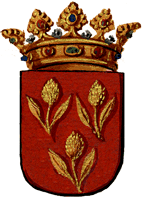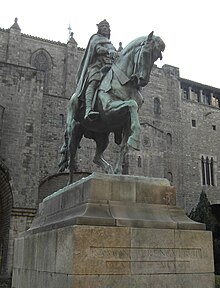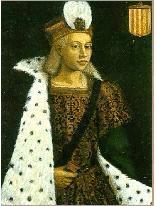Bernat Amat de Cardona
Bernat Amat de Cardona († around 1155) was a Catalan nobleman who was actually called Bernat Amat de Claramunt, but took the surname de Cardona as heir to the house of the Vice Counts of Cardona . He succeeded his maternal uncle, Folch II. De Cardona, Bishop of Barcelona , (1096-1099) as the first vice count ( Catalan vescomte ) of Cardona (in the center of Catalonia (now in northeastern Spain )) of his house and ruled from 1099 to 1155. Thanks to the mining of the rich salt deposits on his territory, he was one of the richest, and because of his long reign, one of the most influential barons of the Counts of Barcelona, with whom he was related by marriage through his wife and with whom he was a general in their wars supported against the Saracens .
origin
Bernat Amat did not come from the Cardona family, but from the Catalan aristocratic family de Claramunt, which played a not insignificant role in the county of Barcelona . His grandfather of the same name, Bernat Amat de Claramunt († n. 1064), Lord of Tamarite de Litera , was one of the leading barons at the court of Count Raimund Berengar I of Barcelona (1035-1076). In recognition of his military service, he received the title of Vice Count of Tarragona , took part in the famous conquest of Barbastro in 1064 and was one of the barons who signed the deed with which the so-called Usatges de la Cort de Barcelona ('Customs of the court in Barcelona ') - one of the first written summaries of feudal law in Europe.
Bernat Amat's father was Deodat Bernat de Claramunt († n. June 3, 1096), who, like his father, had the title Vice Count of Tarragona, but was never able to exercise this rule, as the city continued to be in the hands of the Muslim emirs of Saragossa found. It is the historical merit of Deadat Bernat that, through a “political” marriage, he created the conditions for his family to acquire the Vice-County Cardona. Bernat Amat's mother was Ermessenda de Cardona († 1083/87), the only daughter of Raimund Folch I. de Cardona through whom the Vice-County Cardona fell to the House of Claramunt.
Bernat Amat had two brothers:
- Ramon Folch de Cardona († December 5th, 1151), documented by a donation on June 3rd, 1096, certified on December 5th, 1151.
- Guillem de Cardona († December 5, 1151), tested together with his brother Ramon on December 5, 1151
Life
Early years
Bernat Amat de Claramunt later de Cardona - probably grew up in the castle of his maternal ancestors, the Castell de Cardona , which still dominates the small town of Cardona (in the Bages district) in the province of Barcelona , but now as a Parador de turismo ('castle hotel') serves. He had two hopes for his future - that one day he would either conquer the city of Tarragona (now the capital of the province of the same name in the Autonomous Community of Catalonia ) and thus not only bear the title, but also exercise effective rule over this vice-county , or that his inheritance claim to the Vice-County of Cardona comes into play. At first, neither seemed likely, because Tarragona was still owned by the Saracens and in Cardona, in addition to his grandfather Raimund Folch I de Cardona, there was also his brother Folch II and in the next generation a male heir: his mother’s brother, Bremond II. De Cardona.
A turning point emerged in 1086 when Bernat Amat's grandfather, Raimund Folch I de Cardona, fell at the Maldà Castle (today in the municipality of the same name in the province of Lleida) in the course of one of the frequent border battles in the battle against the Saracens, and at the same time his only son and heir, Bremond II. de Cardona, fell into captivity by the Muslims and died shortly afterwards in captivity.
The vice-county therefore passed to the last agnate of the House of Cardona, Folch II. De Cardona, the younger brother of Raimund Folch I de Cardona, who, however, was a clergyman, later bishop of Barcelona and therefore had no children.
Acquisition of the Vice County of Cardona
Shortly thereafter, on May 12, 1087, the transfer of the Vice-Countess Cardona to the House of Claramunt was contractually regulated by a deed in which Folch II - the incumbent Vice-Count of Cardona - his niece Ermessenda de Cardona and her husband Deodat Amat de Claramunt agreed that the Vice-County of Cardona should fall to one of the sons of Deodat Amat and Ermessenda. In a deed of donation dated December 26, 1087, Bernat Amat appears next to his uncle with the title of Vice Count. At the latest with the death of his uncle Folch II. De Cardona in 1099, Bernat Amat was able to take over sole control of the Vice-County of Cardona.
His attention was directed, among other things, to strengthening the economic situation of his vice-county by specifically promoting the extraction of the rich salt deposits and thereby greatly expanding his financial possibilities. He used this to strengthen his ties to the diocese of Barcelona , to which he and his wife Almodis gave a regular foundation in the form of salt in 1103.
In the service of the Counts of Barcelona
Bernat Amat remained true to the traditional role of the House of Cardona by not only taking over the name of this family, but also continuing their active participation in domestic politics, as well as in the omnipresent military conflict between the county of Barcelona and the neighboring Muslim states.
The position of the House of Cardona was reinforced by the fact that Bernat Amat was married to Almodis of Barcelona, a sister of the ruling Count of Barcelona. It was Raimund Berengar III. , called "the great" (* 1082 in Rodez , † 1131 in Barcelona ), the Count of Barcelona , Girona and Osona (from 1082 together with Berengar Raimund II and from 1097 alone), Count of Besalú , and Cerdanya and from 1112 also Count of Provence , which belonged to the Holy Roman Empire .
Bernat Amat took a privileged position at the court of the Counts of Barcelona as one of the richest magnates and brother-in-law of the ruling count, and therefore undoubtedly had to implement the ambitious goals of his liege lord to expand the extensive territorial possessions.
So he could the county Besalu by the marriage of his child daughter with the 50-year-old Count Bernhard III. initiate, in 1117 after the blessed death of Count Bernhard Wilhelm von Cerdanya, seize his county and by marrying Dulcia von Gévaudan on February 3, 1112 take over the county of Provence. The domain of the Counts of Barcelona therefore extended in the east to Nice .
Military actions
Bernat Amat also made a contribution to the expansionary policy of Count Raimund Berengar III in the military field, as a general and through his large number of troops. from Barcelona, who thereby acquired the designation "the great".
In 1101 he took part in the final conquest of the city of Barbastro, which was already the subject of a forerunner of the Crusades against the Muslims in 1064, but was recaptured three times by the emirs of Saragossa, but finally the alliance between Pedro I, King of Aragon (1094– 1104), the Count of Barcelona and Count Armengol IV of Urgell (1092–1102) could not resist.
Bernat Amat also took part in the conquest of the city of Balaguer , which was established at the turn of the year 1100/1101 by a coalition between Count Raimund Berengar III. of Barcelona and Pedro Ansúrez , Count of Liébana , Saldaña and Carrión de los Condes . Bernat Amat also took part in the campaign that his brother-in-law, Count Raimund Berengar III. carried out against the Barearic Islands in 1114 and 1115 in collaboration with the Italian Maritime Republics of Pisa and Genoa , as Mallorca and Ibiza had developed into bases for Moorish pirates, which severely impaired Christian shipping in the Mediterranean. It is not clear whether Bernat Amat also took part in the Count of Barcelona’s attacks against Muslim coastal cities such as Valencia , Lleida and Tortosa , but it can be assumed. Bernat Amat also took part in the conquest of Tarragona in 1118. Although his grandfather had already held the title of Vice Count of Tarragona, this important city was not assigned to him, despite theoretical claims. Probably to avoid that this most influential baron in the county of Barcelona would become too powerful.
After Sobrequés Vidal, Bernat Amat took part in the conquest of the important port city of Almería (today in the autonomous community of Andalusia ) in 1147 - which was lost to the Almohads again 10 years later - and in 1149 in the one against Lleida .
Ecclesiastical foundations and death
Despite his combative nature, Bernat Amat was probably also pious and a friend of the reform movement of the French Abbey of Cluny , since he transferred property to this monastery on November 10, 1113 together with his wife and sons. After Sobrequés Vidal, Bernat Amar did not die until around 1155 and therefore survived his sons, so that he was followed by his grandson Raimund Folch II. De Cardona as the second Vice Count of Cardona from the House of Claramunt. Regarding the year of death, however, there are differences of opinion, as Charles Cawley, for example, states “after October 27, 1135”, which is true with c. 1155 is compatible, but creates uncertainty about the succession, since the second son of Bernat Amat, intended as heir, died "before May 17, 1151".
Marriage and offspring
Bernat Amat married before 1087 Almodis of Barcelona († 1140), a daughter of Raimund Berengar II. Called "Cap d'Estopes" (flat head) († 1054) Count of Barcelona, Girona and Ausona and his wife, Mathilde von Hauteville , princess of Apulia (* around 1059, † after June 6, 1112)., the daughter of the Norman Robert Guiscard , Duke of Apulia and Calabria (* around 1015, † around 1085) and his second wife, the Lombard princess Sichelgaita of Salerno (* 1040, † April 16, 1090) - a daughter of Waimar IV. (* Around 1013, † Salerno June 3, 1052), the prince of Salerno (now the province of Salerno ) and of Capua , duke of Amalfi and of Gaeta as well from 1043 to 1047 even Duke of Apulia and Duke of Calabria , and his wife, Gemma, a daughter of Count Laidulf of Capua.
- children
- Guillem de Cardona, first documented mention between 1113 and 1126
- Ramon Folch de Cardona († v. May 17, 1151) married a woman of unknown origin
- his son: Raimund Folch II. de Cardona followed as second Vice Count of Cardona from the House of Claramunt (c. 1155–1175)
- Berenguer de Cardona, † July 19, 1177
- Pere de Cardona († July 19, 1177)
See also
Individual evidence
- ↑ S. Sobrequés i Vidal: Els barons de Catalunya . Volume 3 of the Catalan Biographies . Editorial Vicens-Vives, Barcelona, 1961, p. 53, note 124.
- ^ Charles Cawley, Medieval Lands [1]
- ↑ S. Sobrequés Vidal: op. Cit. P. 53, note 125.
- ↑ S. Sobrequés Vidal op.Cit., P. 53.
- ↑ [httm: fmg.ac/Projects/MedLands/Catalan%20NOBILITY.htm] Note 1026: Foundation book of the monastery of Cluny VI, p. 929.
- ↑ S. Sobrequés Vidal op.Cit. P. 53.
- ↑ [httm: fmg.ac/Projects/MedLands/Catalan%20NOBILITY.htm]
- ↑ European Family Tables, New Series II. Plate 205 Verlag von JA Stargardt, Marburg, 1984.
- ↑ [httm: fmg.ac/Projects/MedLands/Catalan%20NOBILITY.htm]
literature
- S. Sobrequés Vidal: Es barons de catalunya . Vicens-Vives, Barcelona 1961.
- S. Sobrequés Vidal: Els grans comtes de Barcelona . 4th edition, Vicens-Vives, Barcelona 1985.
- MJ Quintana: Vidas de Españoles célebres. El Cid - Guzmán el Bueno - Roger de Lauria . Colección Austral 826, Editorial Espasa-Calpe SA, 1959.
- Pujades, Géronimo: Crónica Universal de Cataluña . 1829.
- John Julius Norwich: The Normans in the South - 1016-1130 . Longmans, London 1967.
Web links
| personal data | |
|---|---|
| SURNAME | Bernat Amat de Cardona |
| ALTERNATIVE NAMES | Bernat Amat de Claramunt |
| BRIEF DESCRIPTION | Vice Count of Cardona |
| DATE OF BIRTH | 11th century or 12th century |
| DATE OF DEATH | around 1155 |





